Hey There! We may earn a commission from links on this page. This helps support the site and is at no extra cost to you. Thanks!
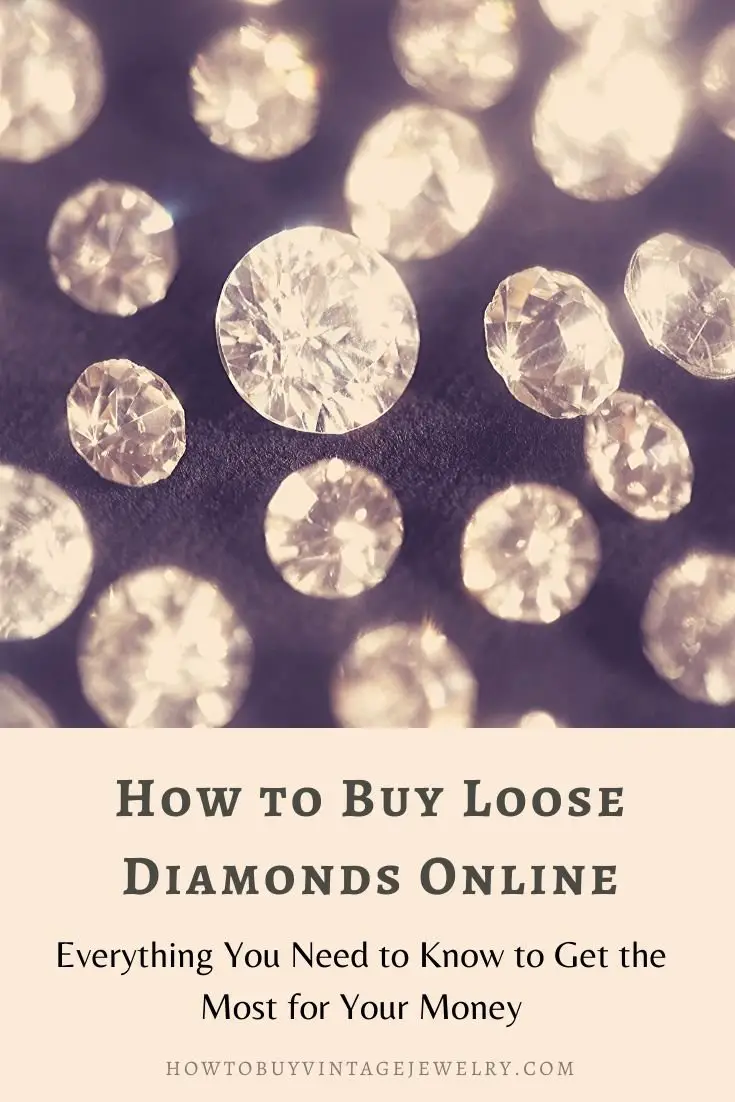
What is it that which is shinier than a star, precious and rare, and comes in all shapes and sizes? Yes... ‘Diamonds’! In this article, you will learn how to buy loose diamonds online.
My reason for choosing diamonds is that, dense as they are, they represent the greatest worth in the smallest volume. – Coco Chanel
We all know that diamonds are one of the best-known and most mesmerizing gemstones available. Transparent and flawless diamonds are highly valued as a precious stone. When you wear a diamond such as a ring or a necklace, it adds immensely to your overall look, but wearing a diamond creates a much bigger impact on your psychological self. You feel valued; you feel worth it; you feel loved and what not!
Buying a diamond is not as simple as it sounds. You need to be very sure of investing in the right stones. If you’ve decided to purchase loose diamonds to build or add to your solitaire collection, or to be used in diamond jewelry like engagement rings or earrings, here are a few things that will help you to make a smart purchase.
Know the 4C's of Diamond Quality
Diamonds are one of the best miracles of nature. Why is a diamond so unique and special? Everyone has a different answer to it: its beauty, its durability, its rarity, or being a symbol of love and commitment.
4Cs of diamond quality is the universal benchmark for assessing the quality of any diamond.
4Cs are Color, Clarity, Cut and Carat Weight. With 4Cs, customers know what exactly they want to purchase and what they are about to purchase.
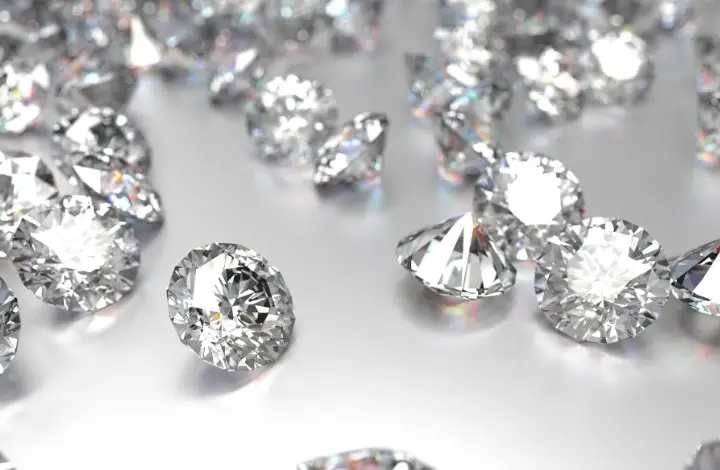
Know your Diamond Certifications
Diamonds are evaluated by independent labs and provide certificates to verify their grading. Diamond Certification (most commonly from labs GIA, AGS, IGI, EGL, GSI, and HRD) is a document you receive from a 3rd party lab that describes a diamond in all of its characteristics.
It is important that you should receive and review a diamond’s lab certification before buying one. The lab report is issued by a recognized grading entity and describes various aspects of the diamond such as color, clarity, length, and width.
The GIA (Gemological Institute of America) is one of the most well-respected and renowned diamond grading entities. GIA has a reputation for rating Color and Clarity, the most subjective scales, more rigorously. Because of GIA’s high reputation, proven consistency, and history, it is recommended to buy diamonds with a GIA or AGS certificate.
Choosing Your Carat Weight Range
Let us first understand about a carat.
Diamond carat weight is basically the measurement of how much a diamond weighs. A modern diamond carat equals 200 milligrams and technically is known as a metric carat. Therefore, a metric carat is 200 milligrams.
The price of a diamond increases with diamond carat weight. (However, an important point to be noted is that a diamond’s worth is assessed using all 4Cs, not just the carat weight.)
Diamond prices rise dramatically at 1 carat. Buying a diamond that is 0.9 c will save you a considerable amount of money.
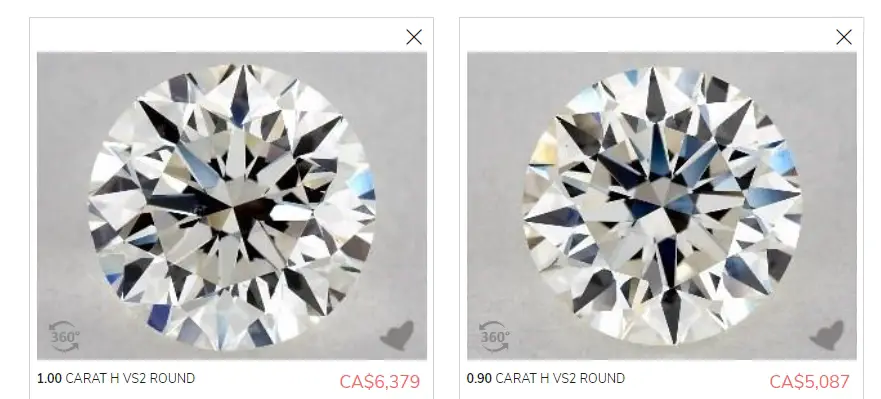
You can see that a 1 carat diamond is about $1300 dollars more than a 0.90 carat diamond of the same color and clarity grade. Screenshot from JAMESALLEN.COM
Choosing the Diamond Cut
Think about how a good haircut can have a huge impact on your appearance and can transform your entire personality!
Similarly, cut is what finally creates the sparkling shine of a diamond. The most vital factor to be considered if you want a sparkling diamond is its ‘cut’. The best quality diamond can look dull and lifeless without a proper cut. It is the craftsmanship and quality cut which gives a diamond its luster and brilliant shine.
Cut refers to the proportions, symmetry, and polishing of a diamond. In a finely cut diamond, light will refract and reflect back in the eyes of the viewer almost completely, thereby giving out a radiant shine. But in a poorly cut diamond (even if it is high color or clarity graded), the light will escape and hence will give out a dull look.
Why is a diamond’s cut the most crucial factor over other factors? It is because a well-cut diamond masks other minor flaws such as blemishes, inclusions and slight coloring too. Another advantage of choosing a well-cut diamond is that you can save your pocket in color and clarity characteristics.
A perfectly cut diamond will have the most ideal proportions for reflecting light along with exceptional symmetry and polish. Each facet is masterfully cut to maximize brilliance, fire, and scintillation.
Brilliance - the brightness of white light reflection
Fire - flashes of colored light seen within the diamond
Scintillation: sparkle which is seen when a diamond or source of light moves
The GIA grades diamond cuts as follows :
- Excellent: the highest level of fire and brilliance
- Very Good: Exceptional and brilliance fire
- Good: Brilliance and sparkle
- Fair: Little brilliance
- Poor: No sparkle, brilliance or fire
One of the 4C’s of diamond quality, the cut quality of the diamond determines the overall beauty and sparkle of the diamond. Therefore, it is recommended to buy a good quality cut diamond over other characteristics.
We recommend opting for a cut grade of Excellent if you can afford it, and at the minimum, Very Good if you are on a tighter budget. To reduce cost, go down in color or clarity grades but keep the cut in the highest grade you can afford. In our humble opinion, a cut grade of Good is not good enough for an engagement ring.

Jams Allen offers their "True Hearts" Cut as their highest quality cut. Screenshot from JAMESALLEN.COM
Note that fancy-shaped diamonds are not given a cut grade by GIA, making them tougher to judge. Shop at a reputable jeweler such as James Allen who can tell you if a diamond is well cut or not. James Allen offers an interactive HD 360-degree video for every diamond in their inventory so you can look at magnified details of the diamond you are considering.
Cut vs. Shape of a Diamond
Often, these terms Cut and Shape are mistaken to be one and the same, and some people also use them interchangeably. However, both these terms are different and have distinct meanings.
- Shape refers to the form or figure of a diamond, whereas cut refers to a diamond’s ability to reflect light through its symmetry, proportions, and polish.
- Diamond shapes can be Round, Oval, Princess, Emerald, etc., whereas a diamond’s cut creates its sparkle.
- A poorly cut diamond, no matter how heavier by weight and prettier by shape, would still appear to be dull.
- You may see vintage diamond cuts such as rose cut and old European cut, these were used before the invention of the modern round brilliant.
Choosing Your Diamond Shape
A very unique and interesting criterion while choosing a diamond is its shape. There are ten basic diamond shapes: round, princess, emerald, asscher, cushion, radiant, pear, oval, marquise and heart.
Few tips to remember while choosing a diamond shape are :
- Round shape: Round diamonds by far are the most popular diamond shape for the engagement rings. They are the most common brilliant-cut diamond. This shape is extremely versatile and classic which looks magnificent in both simple and elaborate settings.
- Fancy diamond shapes: Fancy diamond shapes such as oval or emerald cut are more affordable as less of the diamond is likely to be wasted if cut into a fancy shape. Further, this allows for a larger carat weight of the finished diamond.
- Some shapes appear larger: There are certain diamond shapes that appear larger in an engagement ring. If you are looking for the maximum size proportional to the carat weight, then considering princess and marquise-cut diamonds is a better idea.
- Personal preference: Personal preference is the most important aspect to look for while choosing the diamond shape. You might save some money buying another diamond cut of lower value, but listen to your heart and buy the shape that best fits your interest and desire.
Choosing the Best Diamond Color Grade (for the price)
As diamonds come in different shapes, so do they come in a variety of colors. It is important to pay close attention to a diamond coloring when looking at a range of diamonds.
Some distinct colored diamonds such as pinks and blues are highly-priced whereas the presence of yellow tint in a white diamond reduces its worth. Therefore, whiter a diamond, the more light it will reflect and thus greater will be its value.
The GIA grades diamonds on a scale of D (colorless) to Z (light color). All D-Z diamonds are considered white, even though they contain varying degrees of color. (Note that true fancy colored diamonds such as pinks and blues are graded on a separate color scale.)
- D – F: Colorless
- G – J: Near Colorless
- K – M: Faint Yellow
- N – R: Very Light Yellow
- S – Z: Light Yellow
See the color differences of diamond in the pictures below, they go from a D, to an H, J, and M. Pictures are screenshots from JamesAllen.com

Colorless
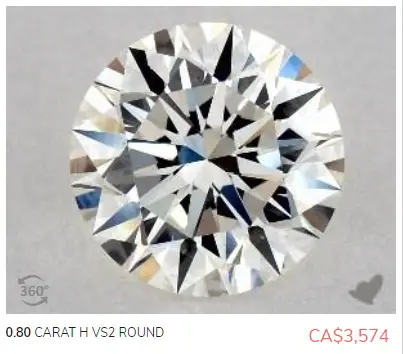
Near Colorless
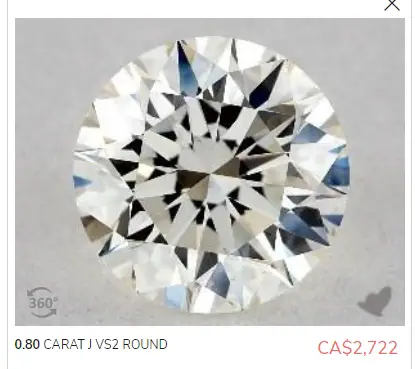
Near Colorless
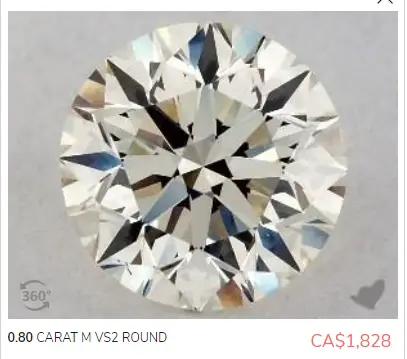
Faint Yellow
Recommended diamond color based on diamond shape and diverse types of settings :
- White Gold / Platinum Solitaire Ring
- Round: H – J (It is extremely difficult to notice the color element in grade quality higher than H)
- Princess, Emerald, Asscher: G– I grades
- All other diamond shapes: F – H grades
- Yellow Gold Ring
- Round: K – M grades (As the diamond color absorbs the yellow color of the gold, any grade higher than a K will look slightly yellowish.)
- Princess, Emerald, Asscher: J – K grades
- All other diamond shapes: I – J grades
- Pave/Side-stone or Halo settings
- Round, Princess, Emerald and Asscher: G – I grades
- All other diamond shapes: F – H grades
- All other diamond shapes for Halo: F – H grades
The 4Cs in totality determine the beauty and brilliance of the diamond. Therefore, it is difficult to differentiate between just one element such as the color or the clarity through untrained eyes and even with expert eyes. Thus, it is an intelligent idea to judge a diamond’s beauty as a whole instead of focusing only on one characteristic.
We recommend going with an H color grade as the sweet spot for money saving without skimping on quality. If you're setting the diamond in yellow or rose gold, you can safely drop to a J or K.
Something to consider if you are buying multiple stones for a ring, or if there are going to be side stones, you must make sure they are all the same color. The central stone must match the color of the side stones or the slight color variation will be much more noticeable.
Round cut diamonds can be safely purchased in the J color range, as this cut will mask the slight yellow color of the diamond.
If you are purchasing a fancy shape such as emerald, pear, or asscher, the color is easier to see. For fancy shapes, we recommend no lower than an H color grade.
Picking the Best Clarity Grade
A diamond has small imperfections internally and on its surface. Diamonds with the least and smallest inclusions (internal defects) receive the highest clarity grade.
Diamond clarity is the assessment of small imperfections internally and on its surface, and grades the visual appearance of each diamond.
Five factors play a crucial role in determining the clarity grade.
- Size: The bigger will be the inclusion, higher will be the impact on clarity grade.
- Nature: Imperfection present on the surface is referred to as blemish, whereas which penetrates the diamond is referred to as inclusion.
- Number: Higher the number of imperfections, lower the clarity grade of a diamond.
- Location: Inclusion present in the closer proximity to the center of the diamond will have the highest impact on its clarity grade.
- Relief: Relief refers to the contrast between the inclusion and the diamond color. Higher the relief, higher will be the chances of diamond clarity grading to be affected.
Diamond Clarity Grades
- IF / FL (Internally Flawless / Flawless) : Rare finds - Only about 1% of diamonds fall into the category.
- VVS1 and VVS2 (Very Very Slightly Included): Excellent quality - VVS1 refers to very very small flaws in the bottom half of the diamond, VVS2 may have these flaws in the top half of the diamond as well.
- VS1 and VS2 (Very Slightly Included): Best Value - Slightly larger internal flaws or multiple smaller ones, these are barely visible to the naked eye. VS1 diamonds are always eye-clean. VS2 diamonds are usually eye-clean as well. VS2 may have bigger flaws located more towards the top or center.
- SI1 and SI2 (Slightly Included): Most popular - Inclusions are easily seen under magnification, and sometimes with the naked eye. SI2 has inclusions that are more likely to be seen by the casual observer.
- I1 - (Included): Not recommended - Diamonds have inclusions that are almost always visible to the naked eye.
You can see in the images below that the lowest clarity grade (I1) has lots of visible inclusions, whereas the middle diamond, with a clarity of VS2 is hardly distinguishable from the highest clarity grade (IF) in the last picture.
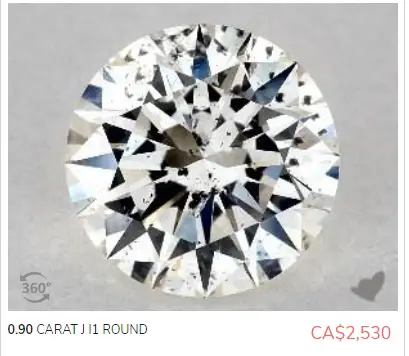
I1 Clarity Grade
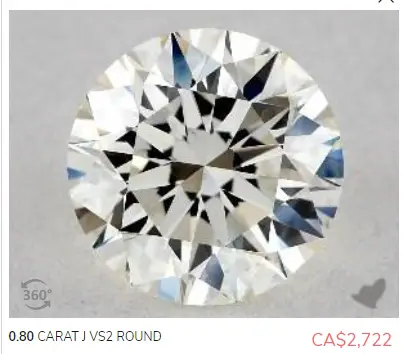
VS2 Clarity Grade

IF Clarity Grade
The location of the inclusions is an important consideration for the overall look of a diamond. Try to find a diamond with inclusions along the edge, these will be hidden by the prongs of the jewelry. Inclusions near the table facet will be the most obvious.
Think about the diamond shape - round cut diamonds are the best at hiding imperfections, whereas step-cut diamonds (such as an emerald or asscher cut) have a large table where flaws are more easily seen. We recommend VS1 or VS2 for step-cut diamonds.
Size makes a difference - larger carat diamonds will show more of their imperfections than smaller carat diamonds. Stick to a VS1 or above for diamonds over 2 carats.
You should observe the diamond for any noticeable blemishes or inclusions. The idea should be to find a diamond that is eye clean without overpaying.
We recommend VS2 clarity grade for the best value. If you are on a very limited budget, you can find SI1-SI2 diamonds that offer even better value, but you will have to examine the diamond to make sure you can't see flaws.
Where to Buy Loose Diamonds
Buying a diamond is an expensive affair. There are a number of diamond retailers and wholesalers, who deal in the sale and purchase of loose diamonds. But it is highly recommended to buy loose diamonds from certified sellers.
As now you are aware that buying a diamond requires a great deal of knowledge and research, the next important step is buying diamonds from an authentic and reputed seller.
One of the most reputed diamond sellers who provide GIA certificates with their diamond is James Allen. They are the leader in online diamond sales. With 18+ years of experience and prime focus on customer satisfaction, they provide excellent pricing. They have the highest tech diamond imagery in the industry, making it easy to accurately search and review diamonds.
Some perks of buying loose diamonds from James Allen are :
- No questions asked returns within 30 days of shipment
- Lifetime warranty
- Free international shipping
- 24/7 customer service
- Best-in-class packaging
- Interactive HD 360-degree video for every diamond in their inventory
- Offers a "True Hearts" Collection of Excellent cut Diamonds.
- Narrow your search parameters for price, cut, clarity, color, shape, and carat.
- Free ring inscriptions and much more…
Click here to visit James Allen and have a hassle-free experience buying your dream stone!
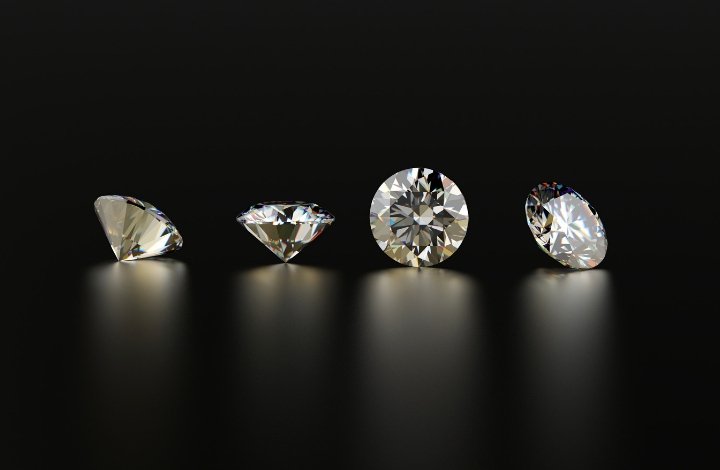
Bottom Line - How to Buy Loose Diamonds Online
The cut of a diamond is the most important factor to consider when purchasing a diamond, it will have the biggest impact on the diamonds appearance. A diamond with excellent color and clarity will still look dull if it is not cut well.
We recommend putting the cut grade of a diamond as your top priority - above carat weight, clarity, and color. Save money by going lower in the color and clarity grades, as an excellent cut will mask these minor flaws, and we all want a diamond that will sparkle. Keep your diamond just below 1 carat in size and you will have the best bling for your money!
so, What it the Best Diamond for Your Money?
If you want a round brilliant diamond, go for an ideal to"True Hearts" cut, with a VS2 clarity grade, J color grade, and a size of just under 1 carat. See the selection of these diamonds on the James Allen Website.
If you want a fancy cut diamond, the best option for your money is to go with an H color grade and a VS2 clarity grade, and a size of just under 1 carat. See the selection of these fancy cut diamonds on JamesAllen.com
We hope you enjoyed this article and found it helpful, let us know in the comments if you need any assistance buying loose diamonds, and we will do our best to help you out!
Happy Shopping,
Andrea

Many thanks to you for giving us such a beautiful article and I have the opportunity to discuss something very nice through your article. Every girl loves jewelry I am one of them .I especially love Diamond Jewelry a lot .We often do not buy Diamond Verified at all and as a result we are deceived .You have talked about many ways to buy real diamonds and I hope that if anyone follows them they will never cheat on buying diamonds again. Personally, when I go to buy a diamond, I see some of my own lab stickers. Notable among them is GIA. And I hope that many of people will be aware of this after reading this article and will share their experiences with you very soon.
Oh my goodness you know your stuff!
Thanks so much for this wonderful article, I”m definitely keeping it. My husband might not know it yet, but our 20th wedding anniversary is coming up, and I’m planning on an extra stone on my finger.
We have 2 loose emeralds which I’m hoping to have set in platinum with the diamond I acquire. What color do you think would look best? I mean, will the green of the emeralds make the diamond appear whiter, or more yellow? I take to heart what you said about using something from H to J in a platinum ring, I was just wondering.
Thanks again for your article, I’m looking forward to making an informed choice.
Hi Sam, will you be purchasing a round diamond? If you do, a J color would be a budget-friendly choice. If you are going with a fancy-cut diamond, I would say you would be better to stick with an H color. I don’t think you will notice much color in either diamond choice, but the emerald may bring out more yellow in the diamond next to it.
This article is excellent in it’s formatting style, thoroughly researched, visually pleasing, and a real delight to comment on. I learned so much that I did not know about diamonds, and your article explained all I need to know. I’m sure that any diamonds I buy in the future will indeed be a pleasurable experience. I will come armed with the expert information your article has provided. Thank you, and I will share this informative article with my contacts, and wish you every success in this amazing site you have created.
Great guide to buy loose diamonds online. I looking for the same and found it very useful for me. Thanks and keep sharing.